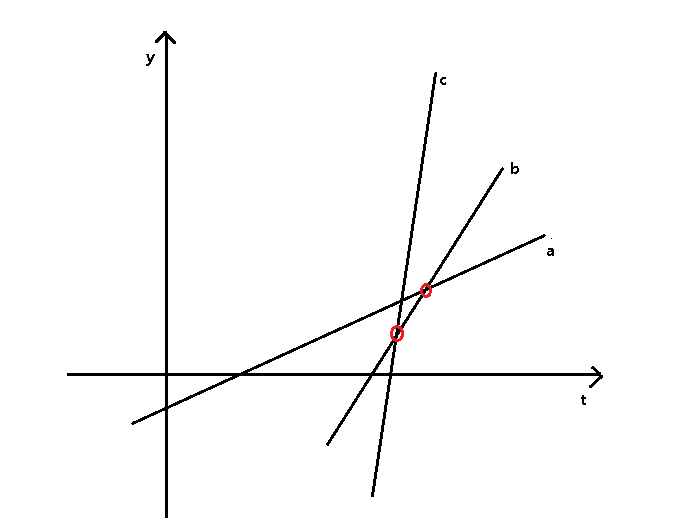Think of every car as a straight line: y = v * t + b
Where v represents speed, t represents time, and b represents initial position
The problem becomes: finding the existence of t makes the y value of the line the largest among all the lines (the same size is allowed)
The specific method is
- Sort the lines by v (slope)
- For an ordered line a, b, c, if the intersection of b, c is to the left of the intersection of a, b, round off b
(as shown in the figure, b can never lead)

3. Because t > = 0, the case that the intersection point is not in the first quadrant is eliminated.
ps: horizontal coordinate calculation method of intersection of two lines:
y=k1*x+b1 ①
y=k2*x+b2 ②
From ① and ②, it can be concluded that:
k1*x+b1=k2*x+b2
(k1-k2)*x=b2-b1
x=(b2-b1)/(k1-k2)
#include<queue> #include<cstdio> #include<cstdlib> #include<iostream> #include<algorithm> using namespace std; const int maxn=500010; int n,sta[maxn],id[maxn],ans[maxn]; struct Car{int b,k,id;}c[maxn]; int top=0,cnt=0; bool flag[maxn]; bool cmp(const Car &a,const Car &b){ return a.k<b.k||(a.k==b.k&&a.b>b.b); } double getx(int x,int y){ if (c[y].k-c[x].k==0) return 1e10; return (double)((double)c[x].b-c[y].b)/(double)(c[y].k-c[x].k); } int main(){ scanf("%d",&n); for (int i=1;i<=n;++i) scanf("%d",&c[i].b); for (int i=1;i<=n;++i) scanf("%d",&c[i].k); for (int i=1;i<=n;++i) c[i].id=i; sort(c+1,c+n+1,cmp); sta[++top]=1; id[top]=c[1].id; for (int i=2;i<=n;++i){ if (c[i].k==c[i-1].k&&c[i].b<c[i-1].b) continue; while (top>1&&getx(sta[top-1],sta[top])>getx(sta[top],i)) top--; sta[++top]=i; id[top]=c[i].id; } for (int i=2;i<=top;++i) if (getx(sta[i-1],sta[i])<0) flag[i-1]=1; for (int i=1;i<=top;++i) if (!flag[i]) ans[++cnt]=id[i]; sort(ans+1,ans+cnt+1); printf("%d\n",cnt); for (int i=1;i<cnt;++i) printf("%d ",ans[i]); if (cnt) printf("%d",ans[cnt]); }